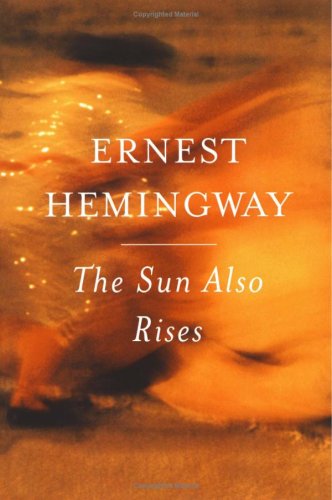Our book group choice for August 2006 is The Sun Also Rises by Ernest Hemmingway. The quintessential novel of the Lost Generation, it is one of Ernest Hemingway’s masterpieces and a classic example of his spare but powerful writing style.
The Sun Also Rises, also known as Fiesta, is a 1926 novel by American writer Ernest Hemingway. The novel portrays a group of American and British expatriates who travel along the Camino de Santiago from Paris to the Festival of San Fermín in Pamplona and watch the running of the bulls and the bullfights. An early modernist novel, it received mixed reviews upon publication. Hemingway biographer Jeffrey Meyers writes that it is now “recognized as Hemingway’s greatest work” and Hemingway scholar Linda Wagner-Martin calls it his most important novel. The novel was published in the United States in October 1926 by Scribner’s.
The novel is narrated by Jake Barnes, a war veteran who is now impotent. Jake is in love with Lady Brett Ashley, a twice-divorced Englishwoman with a string of lovers. Brett is attracted to Jake, but she is also unable to commit to a relationship because of her own sexual past.
The novel follows Jake and Brett as they travel to Pamplona for the Festival of San Fermín. They are joined by a group of friends, including Robert Cohn, a Jewish writer; Bill Gorton, a journalist; and Mike Campbell, an American who is married to a Spanish woman.
The festival is a time of drinking, feasting, and bullfighting. Jake and Brett watch the running of the bulls and the bullfights, and they also participate in the festivities. However, the festival is also a time of tension and conflict. Jake and Brett’s relationship is strained by their inability to be together, and Cohn’s jealousy of Jake leads to a fight.
The Sun Also Rises is a powerful novel that captures the disillusionment and despair of the Lost Generation. The characters in the novel are all searching for something, but they are unable to find it. They are all lost, both physically and emotionally. The novel is a reminder that life can be meaningless and empty, but it is also a reminder that there is still beauty to be found in the world, even in the midst of despair.
Discussion Questions
- When Jake Barnes rebuffs the prostitute Georgette because he is “sick,” she says, “Everybody’s sick. I’m sick, too” (p.23). Is Georgette’s observation an appropriate description of the people in the novel? Why is Jake’s emasculating wound such an effective symbol?
- When Jake and Bill walk during the Paris evening looking at Notre Dame, watching young lovers, and savoring cooking smells, Jake asks whether Bill would like a drink. Why does Bill respond, “No…I don’t need it” (p. 83)? Why does Jake say that for Cohn the Bayonne cathedral was “a very good example of something or other” (p. 96)?
- Is Jake and Bill’s fishing trip to Burguete relevant to the epigraph from Ecclesiastes? How do their conversations in Burguete differ from those they have back in Pamplona? How do Robert’s, Mike’s, and Brett’s absences from the fishing trip set them apart from Jake and Bill? Why is the Englishman Harris included in the Burguete scene?
- How would you describe Jake Barnes’s relationship with Brett? Does he love her; understand her? Is his view of Brett constant? How does he see her at the close of the novel? What does he mean when he says, “Isn’t it pretty to think so,” when Brett tells him that they “could have had such a damned good time together” (p. 251)?
- If Hemingway’s novel is about “the lost generation,” do we conclude that all five of the persons who have gone to Pamplona are lost? Is there evidence that moral or spiritual cleansing ever takes place in the novel?

